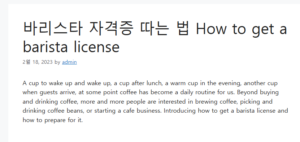A cup to wake up and wake up, a cup after lunch, a warm cup in the evening, another cup when guests arrive, at some point coffee has become a daily routine for us. Beyond buying and drinking coffee, more and more people are interested in brewing coffee, picking and drinking coffee beans, or starting a cafe business. Introducing how to get a barista license and how to prepare for it.

Types of barista licenses 바리스타 자격증 따는 법
There are many different types of barista licenses. Therefore, you can choose a certification that suits your purpose and prepare for the acquisition. Both written and practical tests are required. There are many types of private certifications, but in Korea, the barista 1st/2nd certification (KCA) of the [Korea Coffee Association] is common, and international barista certifications include SCA (Specialty Coffee Association), IBS (Italian Barista School), and GCS. (Global Coffee School) is well known.
Those who study more professionally for overseas working holidays, employment as a barista, or cafe entrepreneurship may obtain an international barista license. SCA has high overseas public confidence and recognition, IBS can learn authentic Italian coffee and coffee cocktails, and GCS is relatively new and has low recognition, but it has the goal of cultivating international standard baristas such as reserve/customizing. 좋은뉴스
In Korea, many people acquire the Korea Coffee Association Barista Level 1/2 Certificate, which is a private qualification.
How to get a barista license
※ Go to Korea Coffee Association
https://www.kca-coffee.org/
First, let’s look at how to get a level 2 barista license. It is divided into a written test and a practical test. In the written test, you will solve 50 multiple-choice questions in the areas of Introduction to Coffee Studies/Coffee Roasting and Flavor Evaluation/Coffee Extraction. The time limit is 60 minutes. There is no qualification for the 2nd grade barista, so anyone can challenge.
In the practical test, technical and sensory evaluations are conducted on test preparation/espresso/cappuccino/service skills. The test time is 5 minutes preparation time and 10 minutes demonstration time. A score of 60 or higher out of 100 is required to pass.
On the other hand, there are also those who are exempt from the written test. Those who have barista level 3, those who have completed 9 credits or more of courses in related professional departments at universities, and those who have completed barista academy.
Foreigners or naturalized Indians can skip the written test and take the practical test if they have completed 6 credits of coffee courses at an Indian university or received more than 54 hours of education at other educational institutions. The same goes for people with disabilities. In the case of exemption from writing, fact-checking with related documents is required.
Here’s how to get a first-class barista license. First of all, there is a premise that a level 2 barista qualification is required to take the test.
The written test will also solve 50 questions in 60 minutes, including a small number of coffee questions in English along with multiple choice questions. The scope of the questions is Introduction to Coffee Studies/Coffee Roasting and Flavor Evaluation/Coffee Extraction/Our Tea.
We will also take a look at the barista level 1 practical test. The practical test is divided into preparation posture/4 cups of espresso/4 cups of cappuccino. When preparing in advance, select the provided coffee beans and grinder, set the grinding degree suitable for the coffee beans, and check the flavor. Afterwards, he makes 4 cups of espresso espresso with these beans and explains the flavor. Next, make cappuccino with 2 cups of rosetta and 2 cups of 3-tiered tulips and submit them to the practical test.
All of this must be done within the test time limit of 10 minutes for preparation and 10 minutes for demonstration. Similarly, a score of 60 or higher out of 100 is required to pass.
As with the 2nd level, there is a special selection for the 1st level barista exam that allows exemption from writing. Those who have acquired at least 15 credits in coffee-related courses at a university educational institution and have averaged at least 70 points for the semester, and those who have completed the barista training school.
There are also practical skill exemptions. The practical test is exempted if you win the prize with grades from 1st to 6th in the WBC national selection contest hosted by the corporation [Korea Coffee Association].
If you are ready, you need to take the test. After signing up as a member of the [Korea Coffee Association] site, prepare image files to be used on the test ticket, and then deposit the test fee to complete the application.
The fee for the first-class barista written test is 44,000 won, the practical test is 110,000 won, the second-class written test is 33,000 won, and the practical test is 55,000 won.
After registering, check the exam hall, prepare a barista apron, black dress shoes, white shirt, and black pants/skirt for the test, and pass the practical test safely to obtain a barista license. The difficulty is not high, so if you are interested in coffee, please give it a try.